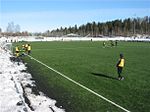Lillestrøm
LillestrømMunicipalities of AkershusSkedsmoSørum

Lillestrøm is a municipality in Akershus county. It is located in the traditional district of Romerike. With a population of 85,757 inhabitants, it is the fourth most populated municipality in Viken. It was founded on 1 January 2020 as a merger between former municipalities Fet, Skedsmo and Sørum. The administrative centre of the municipality is the town of Lillestrøm. The town of Lillestrøm is a part of the Oslo metropolitan area.
Excerpt from the Wikipedia article Lillestrøm (License: CC BY-SA 3.0, Authors, Images).Lillestrøm
Fetveien, Lillestrøm
Geographical coordinates (GPS) Address Nearby Places Show on map
Geographical coordinates (GPS)
| Latitude | Longitude |
|---|---|
| N 59.95 ° | E 11.083333333333 ° |
Address
Fetveien
Fetveien
2004 Lillestrøm, Vigernes
Norway
Open on Google Maps






